Abstract
There are four steps in determining how to manage a clinical problem. The first is to formulate questions that are answerable; the second is to locate and synthesize the evidence needed to answer the questions; the third is to estimate the expected benefits, harms and costs of each option based on the evidence; and the fourth is to judge the relative value of the expected outcomes to conclude whether the benefits are worth the harms and costs. It is impractical to repeat these steps for every clinical decision. Therefore, implicitly or explicitly, physicians rely on guidelines, "rules" that simplify decision making about complex problems. If the methods used to develop a guideline are not explicit it is difficult or impossible to know how much confidence to place in it. Therefore, for common and important clinical problems, physicians should rely on guidelines that are systematically developed using explicit methods.
Full text
PDF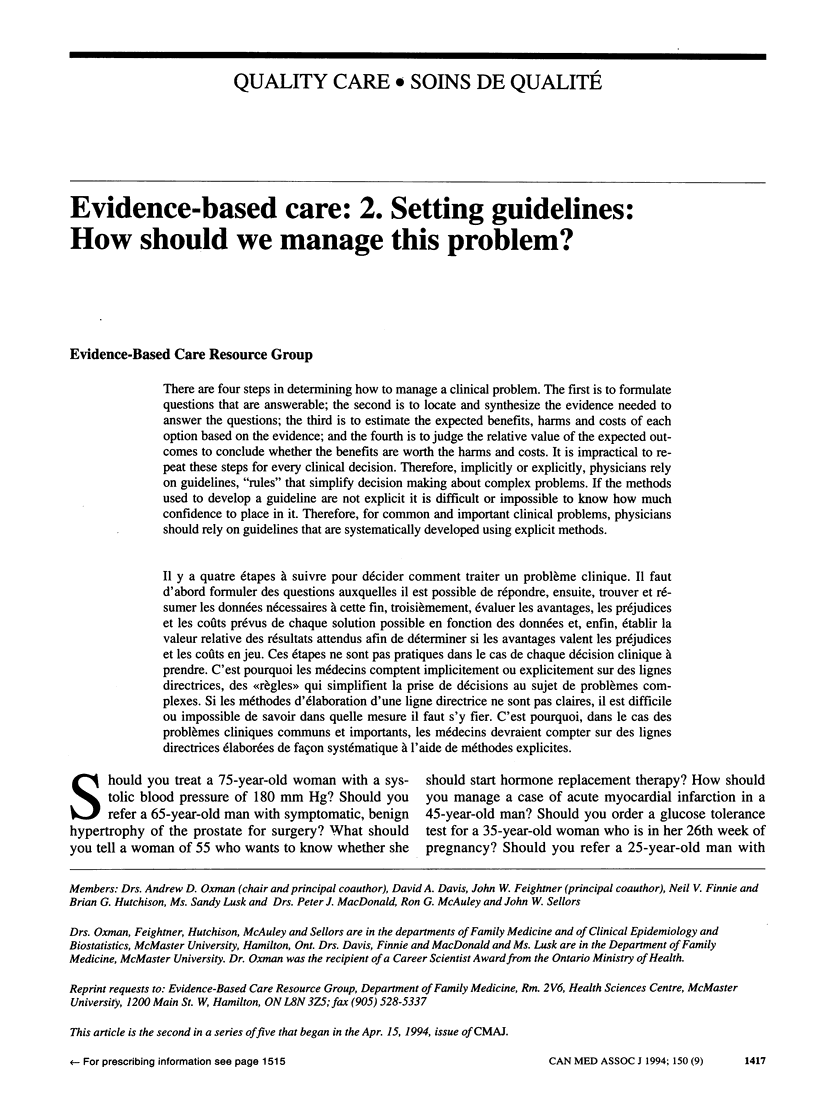

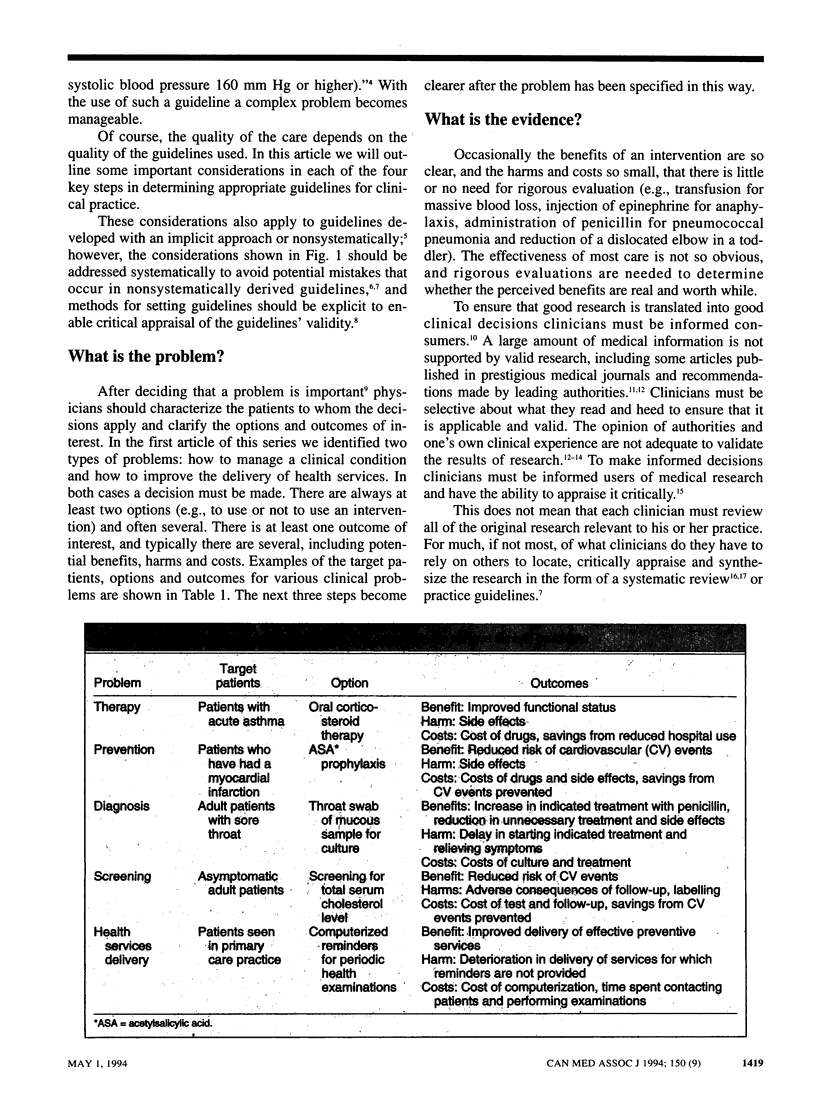
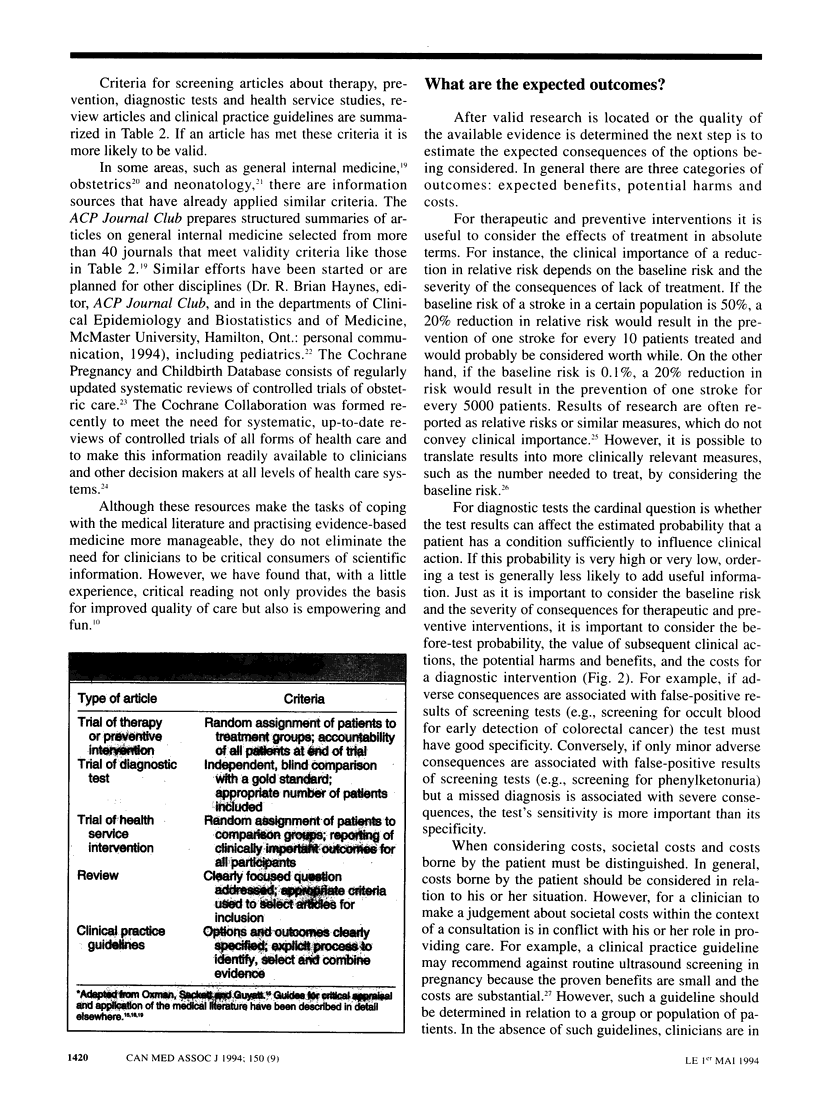

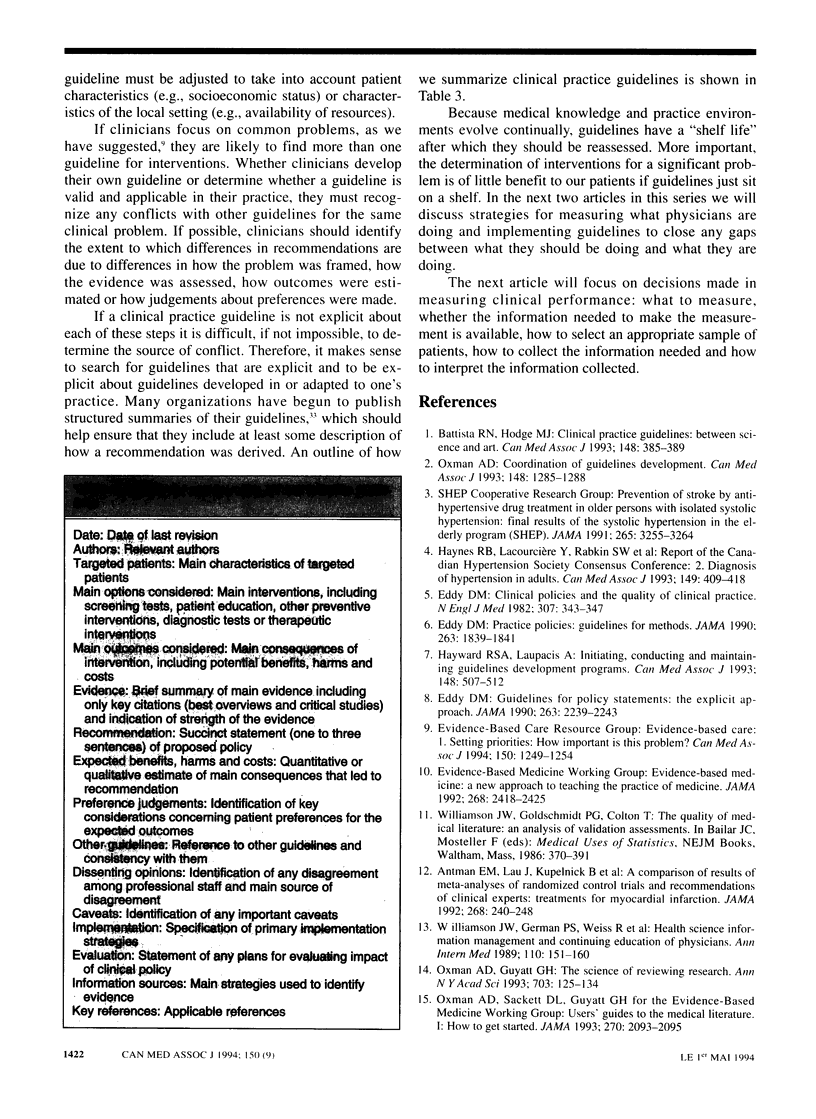
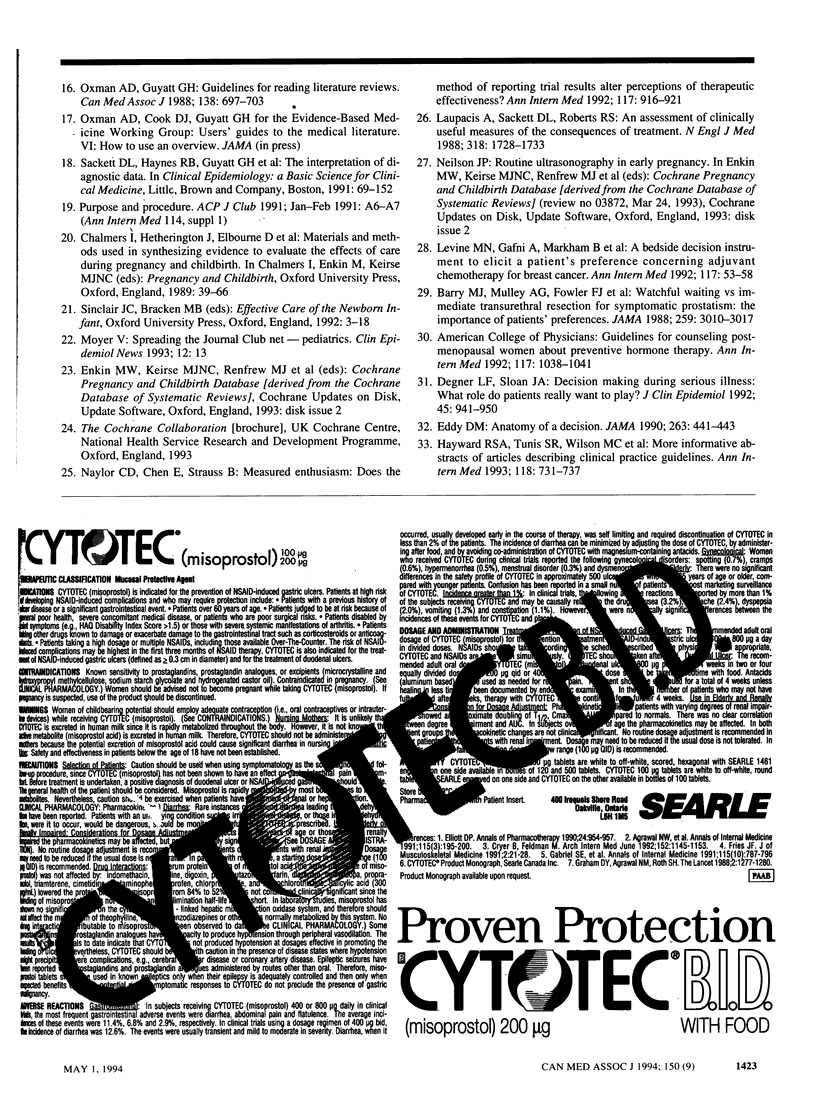
Selected References
These references are in PubMed. This may not be the complete list of references from this article.
- Antman E. M., Lau J., Kupelnick B., Mosteller F., Chalmers T. C. A comparison of results of meta-analyses of randomized control trials and recommendations of clinical experts. Treatments for myocardial infarction. JAMA. 1992 Jul 8;268(2):240–248. [PubMed] [Google Scholar]
- Barry M. J., Mulley A. G., Jr, Fowler F. J., Wennberg J. W. Watchful waiting vs immediate transurethral resection for symptomatic prostatism. The importance of patients' preferences. JAMA. 1988 May 27;259(20):3010–3017. [PubMed] [Google Scholar]
- Battista R. N., Hodge M. J. Clinical practice guidelines: between science and art. CMAJ. 1993 Feb 1;148(3):385–389. [PMC free article] [PubMed] [Google Scholar]
- Degner L. F., Sloan J. A. Decision making during serious illness: what role do patients really want to play? J Clin Epidemiol. 1992 Sep;45(9):941–950. doi: 10.1016/0895-4356(92)90110-9. [DOI] [PubMed] [Google Scholar]
- Eddy D. M. Clinical decision making: from theory to practice. Anatomy of a decision. JAMA. 1990 Jan 19;263(3):441–443. doi: 10.1001/jama.263.3.441. [DOI] [PubMed] [Google Scholar]
- Eddy D. M. Clinical decision making: from theory to practice. Guidelines for policy statements: the explicit approach. JAMA. 1990 Apr 25;263(16):2239-40, 2243. doi: 10.1001/jama.263.16.2239. [DOI] [PubMed] [Google Scholar]
- Eddy D. M. Clinical decision making: from theory to practice. Practice policies--guidelines for methods. JAMA. 1990 Apr 4;263(13):1839–1841. doi: 10.1001/jama.263.13.1839. [DOI] [PubMed] [Google Scholar]
- Eddy D. M. Clinical policies and the quality of clinical practice. N Engl J Med. 1982 Aug 5;307(6):343–347. doi: 10.1056/NEJM198208053070604. [DOI] [PubMed] [Google Scholar]
- Haynes R. B., Lacourcière Y., Rabkin S. W., Leenen F. H., Logan A. G., Wright N., Evans C. E. Report of the Canadian Hypertension Society Consensus Conference: 2. Diagnosis of hypertension in adults. CMAJ. 1993 Aug 15;149(4):409–418. [PMC free article] [PubMed] [Google Scholar]
- Hayward R. S., Laupacis A. Initiating, conducting and maintaining guidelines development programs. CMAJ. 1993 Feb 15;148(4):507–512. [PMC free article] [PubMed] [Google Scholar]
- Hayward R. S., Wilson M. C., Tunis S. R., Bass E. B., Rubin H. R., Haynes R. B. More informative abstracts of articles describing clinical practice guidelines. Ann Intern Med. 1993 May 1;118(9):731–737. doi: 10.7326/0003-4819-118-9-199305010-00012. [DOI] [PubMed] [Google Scholar]
- Laupacis A., Sackett D. L., Roberts R. S. An assessment of clinically useful measures of the consequences of treatment. N Engl J Med. 1988 Jun 30;318(26):1728–1733. doi: 10.1056/NEJM198806303182605. [DOI] [PubMed] [Google Scholar]
- Levine M. N., Gafni A., Markham B., MacFarlane D. A bedside decision instrument to elicit a patient's preference concerning adjuvant chemotherapy for breast cancer. Ann Intern Med. 1992 Jul 1;117(1):53–58. doi: 10.7326/0003-4819-117-1-53. [DOI] [PubMed] [Google Scholar]
- Naylor C. D., Chen E., Strauss B. Measured enthusiasm: does the method of reporting trial results alter perceptions of therapeutic effectiveness? Ann Intern Med. 1992 Dec 1;117(11):916–921. doi: 10.7326/0003-4819-117-11-916. [DOI] [PubMed] [Google Scholar]
- Oxman A. D. Coordination of guidelines development. CMAJ. 1993 Apr 15;148(8):1285–1288. [PMC free article] [PubMed] [Google Scholar]
- Oxman A. D., Guyatt G. H. Guidelines for reading literature reviews. CMAJ. 1988 Apr 15;138(8):697–703. [PMC free article] [PubMed] [Google Scholar]
- Oxman A. D., Guyatt G. H. The science of reviewing research. Ann N Y Acad Sci. 1993 Dec 31;703:125–134. doi: 10.1111/j.1749-6632.1993.tb26342.x. [DOI] [PubMed] [Google Scholar]
- Oxman A. D., Sackett D. L., Guyatt G. H. Users' guides to the medical literature. I. How to get started. The Evidence-Based Medicine Working Group. JAMA. 1993 Nov 3;270(17):2093–2095. [PubMed] [Google Scholar]
- Williamson J. W., German P. S., Weiss R., Skinner E. A., Bowes F., 3rd Health science information management and continuing education of physicians. A survey of U.S. primary care practitioners and their opinion leaders. Ann Intern Med. 1989 Jan 15;110(2):151–160. doi: 10.7326/0003-4819-110-2-151. [DOI] [PubMed] [Google Scholar]


